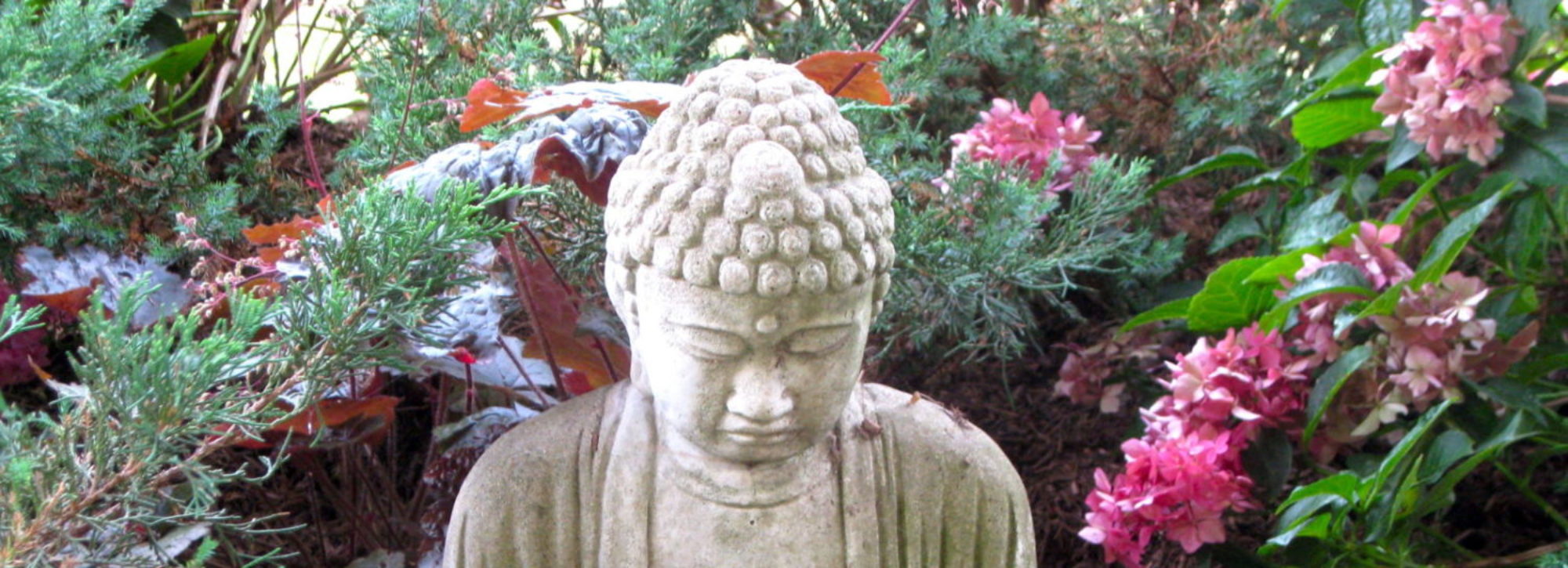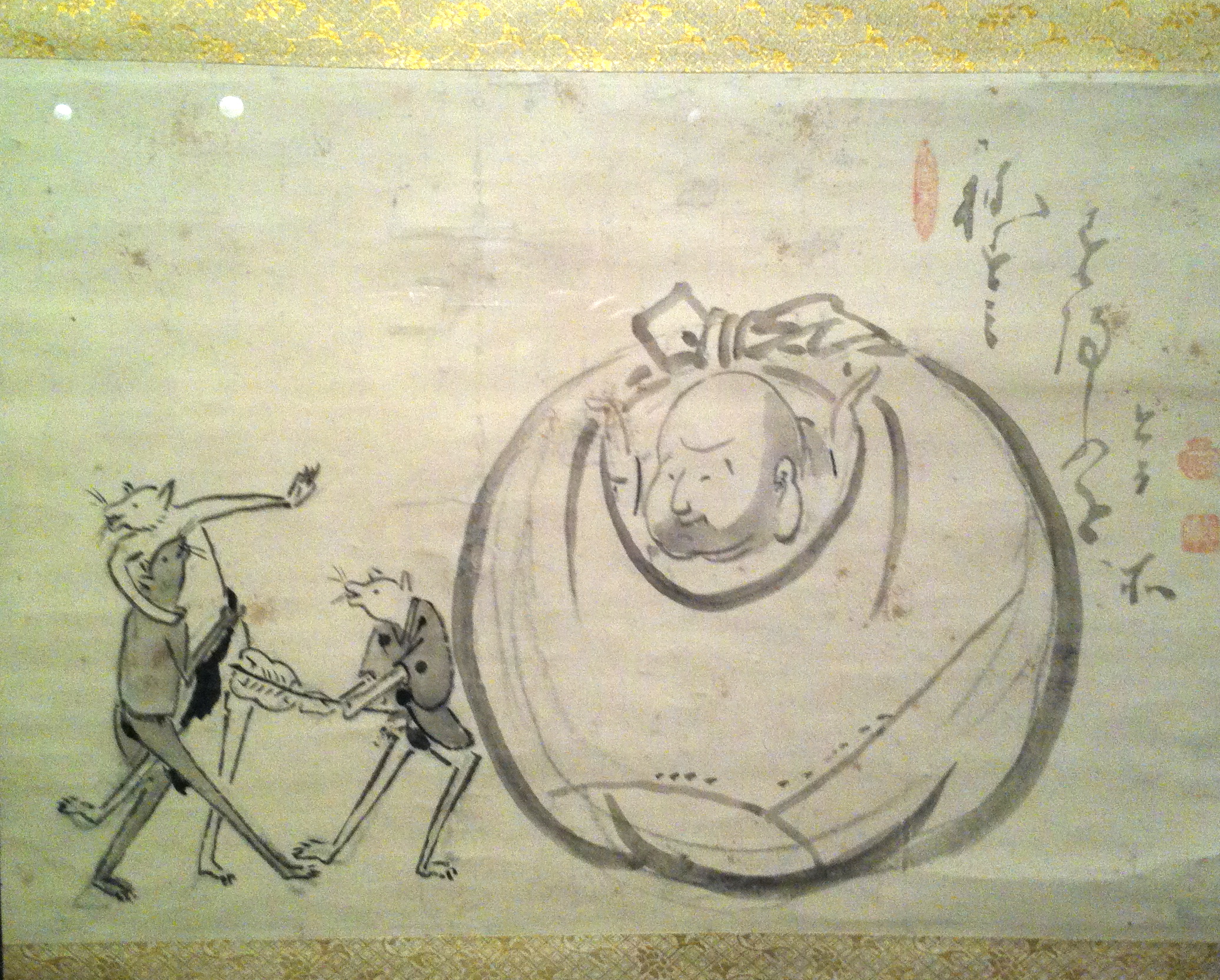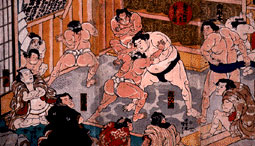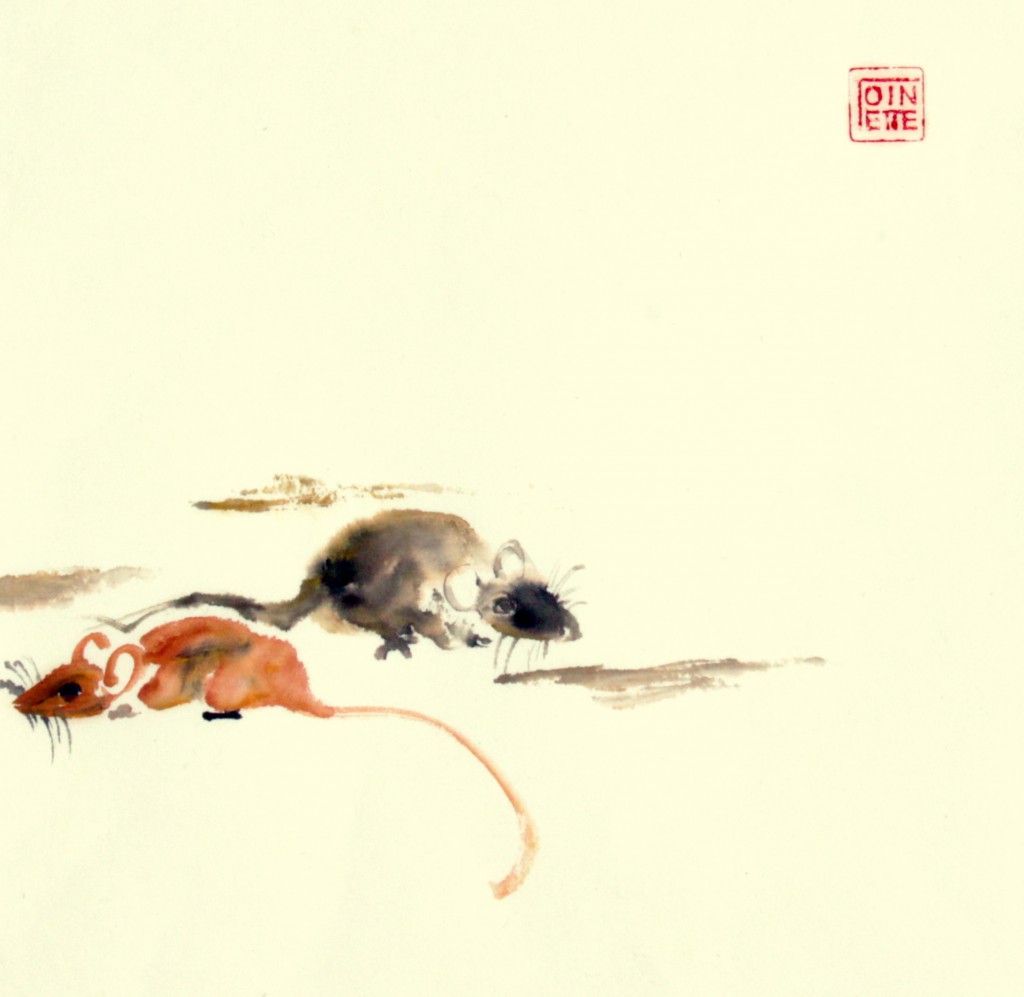Zen Master Hakuin Ekaku (1685-1768) took up brush painting in the last decades of his life. He was a prolific artist producing over 1,000 brushwork scrolls. His painting and calligraphy were more than a creative pastime, however: they were an expression of his enlightenment and a new way of teaching the Dharma to the lay community. His art transcended the boundaries between high and low, sacred and profane, serious and playful, and verbal and visual. They are the very essence of ”no separation.” His rough, simple brushstrokes were also a natural expression of Zen spontaneity and Japanese aesthetics.
Take the following scroll as an example:
The happy fellow on the right is Hotei. In Chinese folklore he’s an eccentric Zen monk and the epitome of contentment. His name means ”cloth sack,” because he carries all his belongings in a bindle wherever he goes. He also stuffs the sack with donations of food and clothing from laymen, and candy to give to children — a veritable fat, jolly, Asian Santa Claus. In this picture, Hotei himself is in his bag — and some have noted that the bag is a kind of ensō or Zen circle symbolizing Enlightenment, non-duality, and/or emptiness. Non-Buddhist Westerners often confuse Hotei with the historical Buddha, and the Chinese themselves sometimes refer to him as The Laughing Buddha. Some believe he is an earthly manifestation of the bodhisattva Maitreya. Legend has it that when Hotei died, he recited the following verse:
Maitreya, the true Maitreya
Has billions of incarnations.
Often he is shown to people at the time;
Other times they do not recognize him.
Hotei also serves duty as one of the Japanese Seven Gods of Good Fortune — the god of abundance and good health.
That’s a lot of weight for that happy little guy to carry in his bindle!
There’s a Zen story about Hotei. When asked ”What’s the significance of Zen?” he put his sack down on the ground. When then asked ”What’s the actualization of Zen?” he picked his sack back up and walked away. Clever Hotei! The very essence of Zen — letting go and dropping off whatever we’re holding. The very actualization of Zen — drawing water and chopping wood. Hotei lives life at the crosshairs of the Absolute and the Relative. A lot like Hakuin himself.
When Hotei was not busy being all these things, he served double duty as Hakuin’s alter-ego and his Everyman. While Hakuin’s Hotei is a spiritual fellow and sits zazen, he also enjoys the pleasures of secular life. In painting after painting we see him puffing on a pipe (and what comes out of the pipe is not a smoke ring, but the prostitute Otufuko!), flying up in the air as a kite, playing go, riding a colt, playing kickball, and street juggling.
In the above painting, Hotei is watching mice sumo wrestling. The colophon on the scroll simply reads ”this is where mice do sumo.” [ref] Many thanks to Professor Stephen Addiss, co-curator of the recent Japan Society Hakuin exhibition, for translating this colophon for me. [/ref] With the rise of the merchant class in 17th century Japan, professional sumo groups were organized to entertain merchants and commoners, and Sumo wrestling moved from the Imperial Court into the public arena. As a boy growing up in a post station on the well-traveled Tokaido road, Hakuin would have been very familiar with sumo.
The painting shows two mice rikishi (wrestlers) with an officiating mouse gyōgi (referee) holding a traditional gunbai (wooden war fan).
Gunbai from Edo era
Sumo grew out of Shinto ritual and rikishi live very regimented lives. In Hakuin’s day they were mostly rōnin (itinerant masterless samurai) trying to support themselves. Today’s rikishi live in communal ”stables” called heya where every aspect of their lives is governed by ritual and tradition. The first rudimentary heya appeared towards the end of Hakuin’s lifetime. During Hakuin’s era, rikishi took part in ten-day kanjin-zumo tournaments where money was raised for Shinto shrines and Buddhist temples.
Woodblock of an Edo era heya
Hakuin is having fun here, but to what purpose? All of his other scrolls have a Zen message, but the message in this scroll seems somewhat obscure.
Could Hakuin have been alluding to parallels between the activities of rikishi and monks? Is Zen training like rikishi training in some way? Is sumo a metaphor for zazen? Could Hakuin have been making fun of sumo by turning the huge wrestlers into small mice? Is Hakuin showing that enlightened beings live with contentment in the world of the ten thousand things? Do the black and white mice represent yin and yang — two, but not two? It all seems so far-fetched, and I have to confess, I have no idea. Maybe, dear reader, you know more about this scroll than I do. I saw it last month at the Japan Society’s exhibit of Hakuin’s painting and calligraphy called The Sound of One Hand. It’s puzzled me ever since. I’d love to hear your suggestions as to its significance. In the meantime I’ll just enjoy it. It makes me smile.
P.S. I thought these mice bore a certain family resemblance to another group of anthropomorphic mice — the Ashkenazic mice of Art Spiegelman’s Maus.
When I asked Art about any possible family resemblance, he only suggested that Hakuin’s mice must be Israeli mice because of their martial arts prowess — definitely not diaspora mice!
P.P.S. My brush painting Dharma friend Toinette Lippe sent me some of her own mice just to demonstrate that not all Japanese mice are anthropomorphic.
If you like Toinette’s mice you can see more of her beautiful work here






Wow, that was a fun romp, thank you !!  Here is another picture on a dish with Hotei and a mouse. I found a few pics with him and mice.
And this page as a Hotei Mouse pic, I think.
Here is a hopeful Japanese video about mice and cat friends.
And in Japanese tradition, a mouse also guarantees a good harvest. Not sure that means anything.
Here’s where your living in Japan for all those years has really paid off, Sabio! And thanks for the movie of Bodhi-cat-va!
Hey Seth … enjoy:
https://www.facebook.com/BuddhistHumor
Thanx!
I found your page searching on Hotei images. In an odd string of occurrences, I had just been doing (or not-doing!) a guided meditation that calls for imagining a “wisdom figure” to appear in response to a particular difficulty. Just when I thought the experience was going to just be another pleasant “meditation,” who should appear but Hotei and his sack. At the moment of his appearance I started to laugh. And the laughter didn’t stop for some time. At the end of the guided meditation I was instructed to imagine that the figure who appeared would whisper some wisdom in my ear pertinent to my particular situation. Hotei approached, and whispered “Give me one penny!” Then we both roared with laughter. I haven’t had such a wonderful laugh in a very long time. Having said all that nonsense, I will dare to offer an interpretation of Hakuin’s incomparable brushwork. Hotei is shown inside his sack looking out. From inside his “sack” – his existence, his “enlightenment,” “the crosshairs of the Absolute and the Relative” as you so eloquently put it – he looks out on the struggles of the mighty. After all, would not the combination of Samurai and sacred Sumo wrestlers not be a rough contemporary equivalent of today’s superheroes? And these mighty individuals, contending for great rewards (wrestling) in the context of the culture (the presence of a referee – unnecessary for mere struggle) are…mice. Does that not suggest the triviality of worldly contests for dominance and reward from a Zen perspective?
Thank you so much for your words…and for making me aware of this lovely picture. A reproduction is about to be hung where I can see it…or, rather, where I can’t miss it! May that ancient Taoist bring you the hearty laughter that blows the clouds of care away!
Many blessings, Gene! You made me smile!
I can only say what associations come to me. Enlightenment = happiness and generosity, and even mice are sentient beings worthy of our kindness. (Scientists have recently found one rat will help another rat if the second rat is trapped, preferring kindness over food!) Even little rats are our teachers! They should be wearing kesa!
http://www.npr.org/2011/12/09/143304206/cagebreak-rats-will-work-to-free-a-trapped-pal
Tim — Mice in kesa; absolutely yes!
Questioning our stereotypes. Experiencing things as they are. Mice doing Sumo!